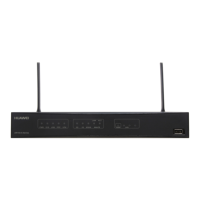l Run the display traffic-policy policy-name applied-record command to check the
application of the traffic policy.
----End
4.5 Configuring Remote Port Mirroring
The remote port mirroring function monitors and analyzes the packets passing an interface of
the AR150/200 when the observing and mirrored devices are on different networks.
4.5.1 Establishing the Configuration Task
Before configuring remote port mirroring, familiarize yourself with the applicable environment,
complete the preconfiguration tasks, and obtain the data required for the configuration. This will
help you complete the configuration task quickly and accurately.
Applicable Environment
The remote port mirroring function monitors and analyzes the packets passing an interface of
the AR150/200 when the observing and mirrored devices are on different networks.
As shown in Figure 4-5, the mirrored interface on the AR150/200 is connected to mirrored
devices. The observing and mirrored devices may use public addresses or private addresses. If
they use private addresses, a VPN tunnel must be configured to allow them to communicate
through the public network. For details about VPN tunnel configuration, see Huawei
AR150&200 Series Enterprise Routers Configuration Guide - VPN.
Figure 4-5 Remote port mirroring network
RouterA
Monitoring
device
Packet flows
Mirroring port
Copied packet flows
IP network
Mirroring port
RouterB
Host A
Pre-configuration Tasks
Before configuring remote port mirroring, complete the following tasks:
Huawei AR150&200 Series Enterprise Routers
Configuration Guide - Device Management 4 Mirroring Configuration
Issue 02 (2012-03-30) Huawei Proprietary and Confidential
Copyright © Huawei Technologies Co., Ltd.
67

